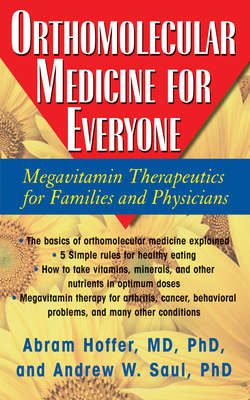Читать книгу Orthomolecular Medicine for Everyone - Abram Hoffer M.D. Ph.D. - Страница 45
THE NAYSAYERS OF ORTHOMOLECULAR MEDICINE
ОглавлениеCritics of orthomolecular medicine have greatly exaggerated the issues of vitamin and mineral side effects and toxicity, and these have even gotten into official, government-issued literature. Many years ago, the U.S. Food and Drug Administration (FDA) distributed 100,000 copies of a pamphlet that contained a number of serious and incorrect charges. When Linus Pauling challenged the FDA to cite the sources for these claims, the agency long delayed answering him, and then later reported that the writer was no longer working for them. Still later, the FDA apologized and admitted they had erred seriously and had ordered that the pamphlet be withdrawn. The pamphlet itself was really no worse than many articles written by a few people with one thing in common— none has ever treated a single patient with orthomolecular medicine, so they have no firsthand experience with either the therapeutic or toxic effects of large doses of vitamins. What was significant about that pamphlet is that the FDA experts were so ignorant of vitamins that they would allow it to be released. Or did they think that the misinformation would go unchallenged?
The few critics of orthomolecular medicine have had easy access to the medical journals, such as the Journal of the American Medical Association, which has consistently refused to publish any rebuttal to attacks on orthomolecular theories. The critics charge that any quantity of vitamins above the recommended doses is unnecessary and therefore wasteful, and secondly that these dosages can be toxic.
The first criticism is merely a statement of the vitamin theory, which has remained unmodified for almost a hundred years. Orthomolecular practitioners have found through clinical experience extending over sixty years that many patients do not get well until they are given these larger doses. These patients do not agree that larger doses are not necessary, and they are pleased to pay the price of the vitamin. Being well is much cheaper than remaining sick. Using large doses is not novel to vitamins—every drug has a therapeutic, effective level which varies from person to person. The amount required for maximum response may be a much larger dose; thus, tranquilizers given by injection are much more effective than the same tranquilizers given by mouth. For some diseases, 40 grams per day or more of an antibiotic are used in order to achieve an effective blood level. This is not considered wasteful, even if most of the antibiotic appears in the urine. It is an illogical requirement of vitamins that only doses that cause no spillover into urine should be used, and it is one that no physician can accept for any medication, including vitamins.
Anything used by humans may be toxic, even food and water. In every case, when a treatment is recommended it is necessary to balance the risks: the risk of the disease not being treated or treated by other drugs, and the risk of the ratio of benefit to side effect. When the disease is life-threatening or threatens to leave the patient chronically ill, any treatment will be used, provided the side effects or toxic reactions are less than the threat of the disease and can be dealt with by the physician. Tranquilizers can be and often are very toxic, yet they must be used. Insulin can be and often is very toxic, but must be used. The basic question then is not the toxicity but the efficacy. If a drug is effective, toxicity must be considered, but the drug will be used until equally effective, less toxic drugs become available. If a drug is not effective, then it should never be used, so toxicity is not a factor. However, critics refuse to accept any of the evidence of the effectiveness of vitamin therapy and they emphasize toxicity as a way of deterring physicians and the public from using vitamins. They understand that vitamins are relatively safer than any other preparations available in a drugstore, but they search for potential toxic reactions. They finally conclude that certain toxicity is possible or can occur, but they never point to any studies indicating that actual patients have been damaged by any vitamin toxicity, or that show an estimate of the proportion of people from the huge number now taking vitamins who have suffered side effects or toxicity.
“After practicing orthomolecular medicine for over thirty-five years, I have seen that vitamins are extremely safe, particularly when one compares them to other patient choices, such as drugs, surgery, or doing nothing and thereby suffering from vitamin deficiency from our modern devitalized foods.” —JERRY GREEN, M.D.
